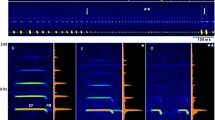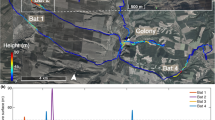Summary
In 5 roosting bats the resting frequency, that is the mean frequency of the cf-portion of consecutive sounds, is kept constant with a standard deviation which varies between 30–120 Hz in different bats and at different days. In 15 bats the emitted sounds were electronically shifted in frequency and played back as artificial echoes. Upward frequency shifts were responded by a decrease of the emission frequency. This frequency compensation occurred at frequency shifts of up to 4400 Hz in all bats and up to 6000 Hz in a few bats. The frequency decrease in different bats over the whole compensation range was 50–300 Hz smaller than the frequency shifts in the echoes. The echoes, therefore, returned at a frequency, called the reference frequency, which was by this compensation offset higher than the resting frequency. The standard deviations of the emission frequency in compensating bats were only slightly larger than in roosting bats and the same in the whole compensation range. All bats started to compensate frequency shifts when they were slightly larger than the compensation offset. Downward frequency shifts were not responded by a change of the emission frequency, but the accuracy with which the emission frequency was kept decreased somewhat. From these results it is concluded that the Doppler shift compensation system of the Horseshoe bats compares the echo frequency with the reference frequency and compensates deviations of upward frequency shifts.
Similar content being viewed by others
References
Neuweiler, G.: Neurophysiologische Untersuchungen zum Echoortungssystem der Großen HufeisennaseRhinolophus fermmequinum Schreber 1774. Z. vergl. Physiol.67, 273–306 (1970)
Neuweiler, G., Schuller, G., Schnitzler, H.-U.: On- and off-responses in the inferior colliculus of the greater horseshoe bat to pure tones. Z. vergl. Physiol.74, 57–63 (1971)
Schnitzler, H.-U.: Die Ultraschall-Ortungslaute der Hufeisen-Fledermäuse (Chiroptera-Rhinolophidae) in verschiedenen Orientierungssituationen. Z. vergl. Physiol.57, 376–408 (1968)
Schnitzler, H.-U.: Control of Doppler shift compensation in the greater horseshoe batRhinolophus ferrumequinum. J. comp. Physiol.82, 79–92 (1973a)
Schnitzler, H.-U.: Die Echoortung der Fledermäuse und ihre hörphysiologischen Grundlagen. Fortschr. Zool.21, 136–189 (1973b)
Schuller, G.: Echoortung beiRhinolophus ferrumequinum mit frequenzmodulierten Lauten. J. comp. Physiol.77, 306–331 (1972)
Simmons, J. A.: Response of the Doppler echolocation system in the bat,Rhinolophus ferrumequinum. J. Acoust. Soc. Amer, in press (1973)
Author information
Authors and Affiliations
Additional information
The work was supported by grants from the Stiftung Volkswagenwerk (Az.: 111858) and the DFG (Az.: Schn 138/1, Ne 146/5).
The authors are indebted to Dipl.-Ing. Hans Zöller who wrote the programs for the on-line analysis with a PDP-12 computer. We also thank Dr. Glenis Long for her suggestions concerning the English.
Rights and permissions
About this article
Cite this article
Schuller, G., Beuter, K. & Schnitzler, H.U. Response to frequency shifted artificial echoes in the batRhinolophus ferrumequinum . J. Comp. Physiol. 89, 275–286 (1974). https://doi.org/10.1007/BF00696191
Received:
Issue Date:
DOI: https://doi.org/10.1007/BF00696191




